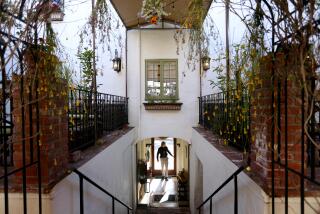Walls Come Tumbling Down, Again
- Share via
CAMBRIDGE, Mass. — When Seiji Ozawa is unhappy with a concerto performed by the Boston Symphony Orchestra, he taps his baton and they all start over. When John Updike hates a chapter he’s written, he shreds it. When architect Graham Gund recently had second thoughts about the house he was building for himself here, he called in a bulldozer.
Down came the walls, roof and four chimneys of the large four-module edifice. Out went the foundations.
Gund, a prominent designer here, started over, more modestly this time. Version Two was relatively conventional: three stories and an attached garage. Then Gund changed his mind again, and over Christmas, the bulldozers reappeared. Now, on one of the few remaining lots in the most exclusive neighborhood of the city, Gund is at it again, with backhoes chewing up the lot for the latest foundation.
On one level, Gund’s dream house interruptus reflects the luxury of indecision that only really big money can buy. The setting of this peculiar community also figures in this tale of 21st century excess, for Cambridge today is anything but a fusty old college town.
My, how the neighborhood has changed: “Cambridge has always been self-conscious about showing its money,” said literary agent Kristin Wainwright. “Now, people aren’t afraid to show their money.”
Cambridge is notoriously polite, but all the noise and dirt from the new site have not endeared Gund to his neighbors. “It’s an eyesore to live with,” sniffed one, who did not want her name used.
Houses where Gund is building, in the prestigious Brattle Street district near Harvard, once known as Tory Row, routinely command price tags of $5 million or more. While catering to the dictates of the powerful Cambridge Historical Commission, the new owners then usually gut the homes to bring them up to snuff.
The unofficial rule, said Wainwright, is to “buy a house that’s way too big for you, then increase it by a third.” Building and rebuilding in this tiny, tony enclave is so out of control that Dorothy Zinberg, a professor at Harvard’s John F. Kennedy School of Government, has a recurring fantasy of “a husband, a wife, a real estate agent, an architect, a landscape architect and a decorator, all standing on the front porch, throwing money at the house.”
Fortunately, there’s plenty to throw. New money is streaming into the city that fancies itself as Athens-on-the-Charles. Young childless couples with recently minted mega-millions from start-up companies, software entrepreneurs and investment banking, engage in bidding wars for crumbling wrecks. In a citadel of intelligentsia, “it’s not thinking money,” Wainwright clarified.
Gund, 59, inherited his money fair and square, from his industrialist father in Cleveland. As befits a scion of old wealth, he counters his spending with philanthropy. He endowed and designed Gund Hall at Harvard, named for his father, provided an endowment in perpetuity for the chairmanship of Boston’s Museum of Fine Arts and has been a generous supporter of the Boston Symphony Orchestra.
But when it came to designing his own house, said Davis Rowley, a Cambridge real estate agent, “he acted a little like a psychiatrist who doesn’t know what to do in his own life.” With a budget of $1.8 million, his current plan calls for four two-story modules of 9,800 square feet.
Rowley said the average sales price for a house near Harvard increased by 16% in the last year alone.
Gund spent years assembling the land package where he is now building. But one curiosity is why Gund, his wife, Ann, and their young son need a new house at all. The 14-room house they now live in, just a few blocks away, is an elegant landmark from 1856, with an assessed value of $2.2 million. The Gunds also have a summer home on Nantucket Island.
Not surprisingly, Gund was in no hurry to talk about deconstruction or reconstruction. “I think he’s terribly embarrassed,” said another architect here, Martha Dwyer.
And since it’s his house, after all, some residents said there’s nothing wrong with Gund wanting to get it right. Besides, the syndrome reinforces the town’s reputation for idiosyncrasy, an endangered trait in this era of brave but bland new wealth.
Battered old Volvos have all but disappeared from Cambridge streets, old-timers lament. Worse, no one sports bumper stickers anymore.
“It’s a lovely community,” Zinberg said. “But it’s remarkable how things have changed.”


